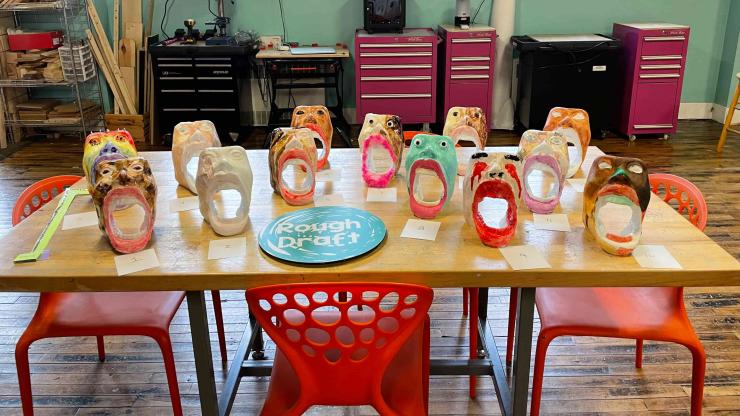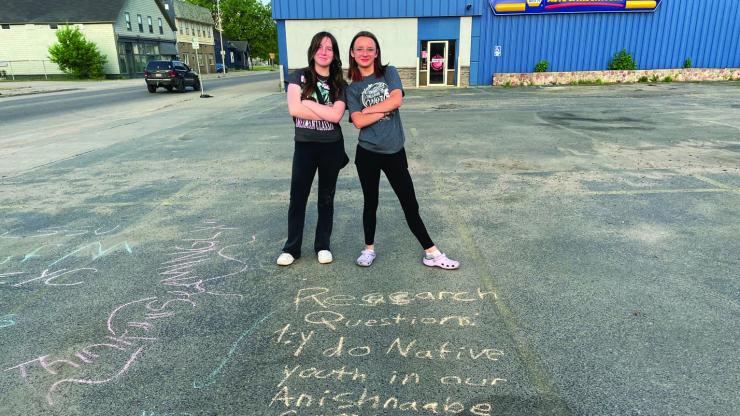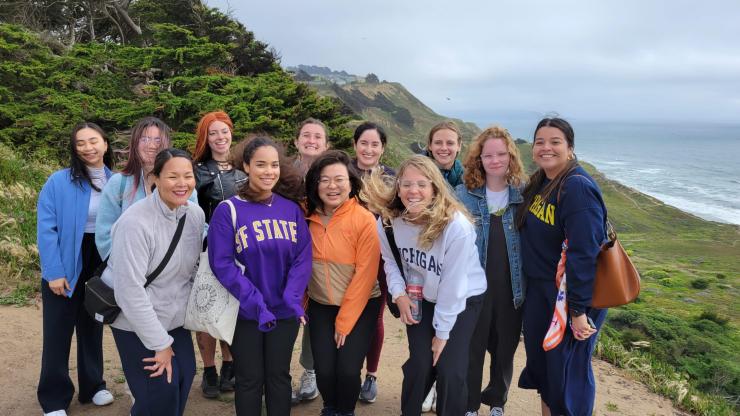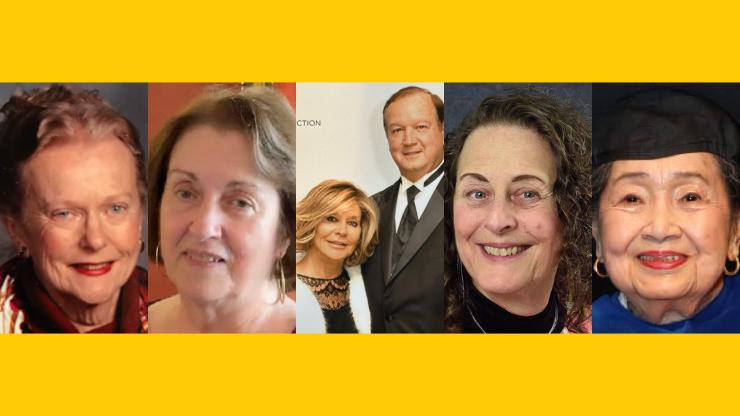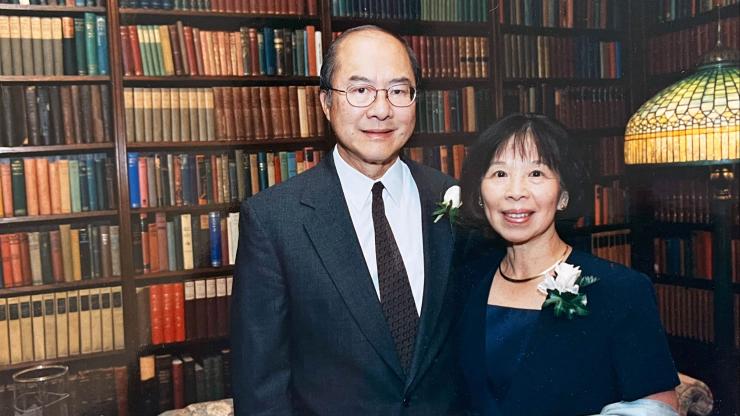
Beyond the Classroom and Into Extended Reality
A new series of online courses has the potential to reach future learning experience designers everywhere
Sitting at the nexus of design, learning theory, and educational technology, the field of Learning Experience Design (LXD) produces virtual and technology-enhanced learning environments that are employed across a range of industries, as well as right here at the University of Michigan. (Think Teach Outs and massive open online courses, or MOOCs.) With demand for talented learning experience designers showing up everywhere from corporate training programs to the National Football League, the Marsal Family School of Education and the University of Michigan’s Center for Academic Innovation (CAI) teamed up to offer the LXD Graduate Certificate Program, a 12-credit certificate available to any U-M graduate student.
Now in its fifth year, the LXD Certificate Program is co-directed by Marsal School Associate Professor of Education Christopher Quintana and Dr. Rebecca Quintana, Director of Blended and Online Learning Design for CAI and a Marsal School Adjunct Lecturer. The certificate combines academic courses on learning theory, curriculum design, multimodal literacies, evaluation, and research design. The hallmark of the program is a residency—or internship—in which students are afforded the unique opportunity of working alongside professional learning experience designers, media designers, and other partners and stakeholders on authentic design opportunities as they engage in a number of projects at CAI.

CAI works with all 19 Ann Arbor schools and colleges across the university, so the range of learning experiences it creates is vast. Over the years, residents have helped design courses that are available on Michigan Online, including Emotional Intelligence: Cultivating Immensely Human Interactions, which explores important intra- and interpersonal skills for thriving in the workplace, and Problem Solving Using Computational Thinking, which explores how to take complex problems, understand what the problem is, and develop solutions in a way that people and computers can understand. However, says Rebecca Quintana, “The residency program can only accommodate a limited number of students per academic year because of the number of projects we can take on here at CAI, and the number of learning experience designers students will be working alongside. We’ve always felt somewhat limited by that, and we want to be able to expand our reach. We think we’ve developed a really good program, a good curriculum, one that we want to be able to share more broadly.”
Since the launch of the program, the Quintanas have fielded many requests from students within the university—and from professionals beyond—who are interested in the LXD certificate. To serve this audience, the Quintanas (along with students from three previous certificate cohorts) have developed An Introduction to Learning Experience Design, a three-course MOOC series that will provide an introduction to the field of LXD and the contemporary applications of LXD. Through the course, learners will grasp the fundamentals of the LXD process and become equipped to apply these concepts in real-world projects.
The three-part series, offered on Coursera, will explain how LXD is related to other types of design, such as instructional design. It will describe key concepts related to LXD, such as design approaches, theories of learning, and evidence-based approaches to instruction. The course will describe the range of “core competencies” with which LXD professionals should be fluent, including the areas of learning theory and motivation, design, assessment, and evaluation, perspectives on designing for diversity and inclusion (e.g., Universal Design for Learning, Culturally Responsive Design), project development and management, and interpersonal and leadership skills.
“It will give our audience of learners a good set of key topics that they know they will need to continue to develop and learn about as they move into the profession,” says Rebecca. “In the MOOC, we encourage learners to be reflective of their own abilities or skill sets and identify others where they may need to grow through self-study or through self-directed learning.”
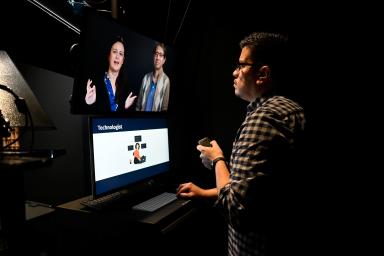
In addition to those seeking a pathway to become learning experience designers, potential MOOC learners might be classroom teachers who have become interested in virtual teaching capabilities since adapting to remote learning during the pandemic or college teachers who are eager to learn more about using technology to support learning.
Perhaps fittingly, designing the course has been an opportunity to explore new types of learning technologies. The Quintanas knew that as an open online course, it wouldn’t offer their global audience of learners the same in-depth experiences afforded in the certificate program—namely the residency component. But they realized they could simulate experiential education by using extended reality (XR) elements, like 360° videos.
“You don’t see a lot of extended reality in online learning. It’s a bit of an experiment,” says Christopher. “We’re using it to create these vignettes where we put the MOOC learner in a project meeting or in a meeting with a faculty member they’re working with. You, as the MOOC learner, are watching a video, but it’s from your perspective. You’re in the meeting, you’re learning about all the roles on the design team.”
The 360° videos are shot in the conference rooms where project meetings occur to give students a feel for those meetings. An Introduction to Learning Experience Design will be one of the first courses the center has produced that uses this type of technology.
“It’s at the cutting edge of this type of work,” says Rebecca. “We don’t have a lot of examples out there of MOOCs that have an immersive component to them.”
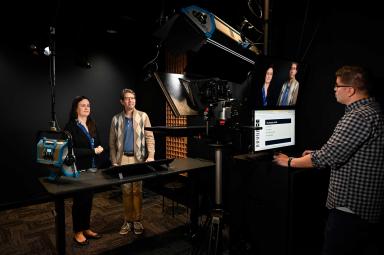
The MOOC is included in CAI’s new Michigan Online Future of Work Academy, one of 10 courses wherein learners will be able to develop skills critical to the future of work and society. The courses leverage XR technology to provide a level of immersion only possible in virtual, mixed, and augmented reality environments.
“When people hear ‘extended reality’ or ‘virtual reality,’ they immediately think you’re wearing a VR headset,” says Christopher. “We’re using a tool called Uptale that lets us create these experiences. The learner can view them if they have a headset—as they move their head, they’re moving around the conference room where they’re having their project meeting.” Learners can also access the Uptale experiences on a phone. Using the phone as a viewer, users can see the conference room space, and interact with it. Although it will be a slightly different interaction, a computer can be used as well.
“We don’t want to limit this to just people who own headsets, because that’s going to be a very small population,” says Christopher. “The Uptale tool allows us to create these immersive experiences on different platforms so that students can access them in any way they want.”
Made with 360° cameras not much larger than an iPhone, the videos are able to capture the full range of an environment, giving learners the experience of being in a project conference room. They can walk in, look around, and read artifacts on the wall that the team is working with. The LXD team will even come in and interact with the learner.
“360° video lets our students interact and feel what it’s like to be in a place,” says Christopher. In one scenario, a learner is situated in the conference room as the project team comes into work. “You’re able to hear what the conversations are like in the project meeting.”
As this new technology becomes available, faculty are starting to brainstorm ideas for how it could be used to enhance their students’ learning. Christopher says that the U-M School of Dentistry created a learning experience where students can explore a virtual dental office. “Dental students can walk around the teeth and look at them in new ways because the virtual stage allows for that.” For medical students, he muses, XR could be used to give a lesson on the heart as the professor delivers the lecture from inside a virtual representation of the muscle. Or it could be used to show data in a new way. “We look at data and graphs, but what if I could create these more understandable 3-D representations of what the data means in a VR environment?”
Of course, to make these virtual learning opportunities possible, we’ll need more learning experience designers. Luckily, An Introduction to Learning Experience Design launches on Coursera in January 2024.

